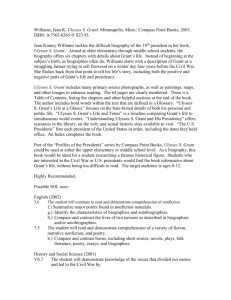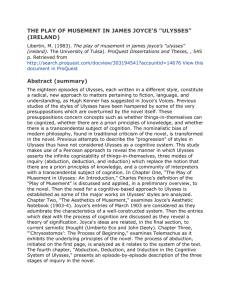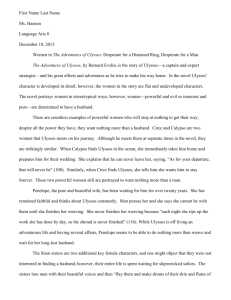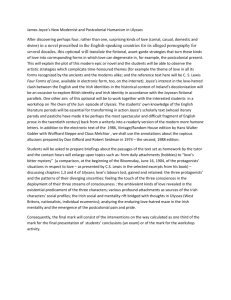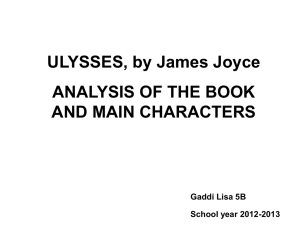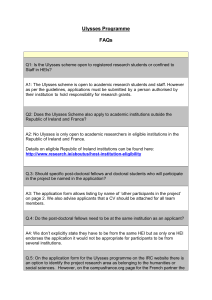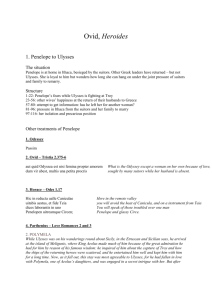The semantics of questions and the focusation of answers
advertisement
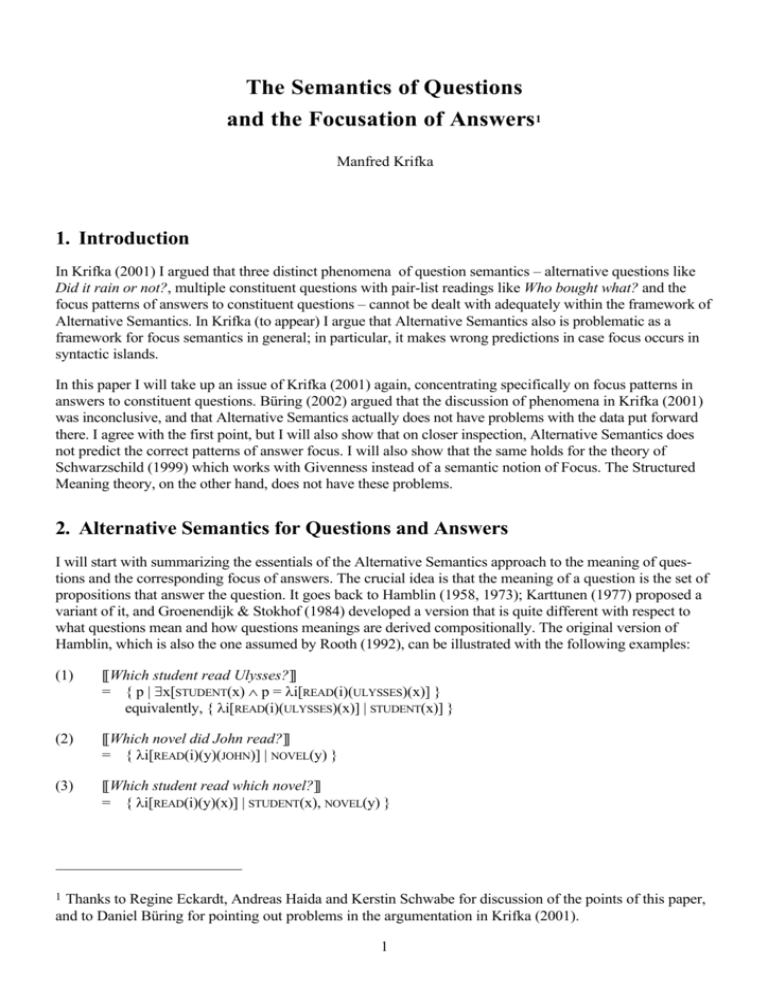
The Semantics of Questions
and the Focusation of Answers1
Manfred Krifka
1. Introduction
In Krifka (2001) I argued that three distinct phenomena of question semantics – alternative questions like
Did it rain or not?, multiple constituent questions with pair-list readings like Who bought what? and the
focus patterns of answers to constituent questions – cannot be dealt with adequately within the framework of
Alternative Semantics. In Krifka (to appear) I argue that Alternative Semantics also is problematic as a
framework for focus semantics in general; in particular, it makes wrong predictions in case focus occurs in
syntactic islands.
In this paper I will take up an issue of Krifka (2001) again, concentrating specifically on focus patterns in
answers to constituent questions. Büring (2002) argued that the discussion of phenomena in Krifka (2001)
was inconclusive, and that Alternative Semantics actually does not have problems with the data put forward
there. I agree with the first point, but I will also show that on closer inspection, Alternative Semantics does
not predict the correct patterns of answer focus. I will also show that the same holds for the theory of
Schwarzschild (1999) which works with Givenness instead of a semantic notion of Focus. The Structured
Meaning theory, on the other hand, does not have these problems.
2. Alternative Semantics for Questions and Answers
I will start with summarizing the essentials of the Alternative Semantics approach to the meaning of questions and the corresponding focus of answers. The crucial idea is that the meaning of a question is the set of
propositions that answer the question. It goes back to Hamblin (1958, 1973); Karttunen (1977) proposed a
variant of it, and Groenendijk & Stokhof (1984) developed a version that is quite different with respect to
what questions mean and how questions meanings are derived compositionally. The original version of
Hamblin, which is also the one assumed by Rooth (1992), can be illustrated with the following examples:
(1)
[[Which student read Ulysses?]]
= { p | ∃x[STUDENT(x) ∧ p = λi[READ(i)(ULYSSES)(x)] }
equivalently, { λi[READ(i)(ULYSSES)(x)] | STUDENT(x)] }
(2)
[[Which novel did John read?]]
= { λi[READ(i)(y)(JOHN)] | NOVEL(y) }
(3)
[[Which student read which novel?]]
= { λi[READ(i)(y)(x)] | STUDENT(x), NOVEL(y) }
1
Thanks to Regine Eckardt, Andreas Haida and Kerstin Schwabe for discussion of the points of this paper,
and to Daniel Büring for pointing out problems in the argumentation in Krifka (2001).
1
I represent propositions as functions from indices (possible worlds or times) i to truth values. Predicates are
dependent on indices; I make the simplifying assumption that arguments are independent of indices. I also
assume for simplification that noun meanings are independent of indices. The meaning of the question
Which student read Ulysses? then is the set of propositions of that can be described as ‘x read Ulysses’,
where x ranges over the set of students, cf. (1).
This representation of question meanings predicts that certain assertions are possible answers, whereas others are not. This is the criterion for congruent question-answer pairs (to be extended later):
(4)
A question-answer pair Q – A is congruent iff [[A]] ∈ [[Q]].
As an example, consider the following assertions as answers to (1). (5.a) is a felicitous answer; its meaning
is an element of the meaning of (1). (5.b,c) are infelicitous answers, as their meanings are not elements of the
meaning of (1).
(5)
a. [[John read Ulysses.]]
= λi[READ(i)(ULYSSES)(JOHN)], where STUDENT(JOHN).
b. [[John read Moby-Dick.]]
= λi[READ(i)(MOBY-DICK)(JOHN)], where STUDENT(JOHN).
c. [[Jill read Ulysses.]]
= λi[READ(i)(ULYSSES)(JOHN)], where ¬STUDENT(JILL).
The criterion that the meaning of the answer must be an element of the meaning of the question is too crude
to exclude answers that may express the right proposition but whose prosody does not fit to the question.
The generalization is that the position of the main accent must correspond to the wh-element of the question
(see Paul 1891 [1880]). With Jackendoff (1972) and many others, I assume that the main accent is determined by a focus feature F in syntax. In modern terminology, we can rephrase Paul’s observation as: The Ffeature of the question must correspond to the wh-constituent of the answer. This is illustrated by the following question-answer pairs.
(6)
a. Which student read Ulysses?
b. JóhnF read Ulysses. / *John read Ul´yssesF.
(7)
a. Which novel did John read?
b. John read Ul´yssesF. / *JóhnF read Ulysses.
(8)
a. Which student read which novel?
b. JóhnF read Ul´yssesF (and MáryF read Moby-DíckF).
In the theory of Alternative Semantics, such correspondences have been captured as follows (cf. von
Stechow (1990), Rooth (1992)). Focus introduces alternatives to regular question meanings; if [[α]] is the
regular meaning of an expression α, then [[α]]A is the set of its alternative meanings. The two propositions in
(6.b) and (7.b) do not differ in their regular meanings, but in their alternatives. In the following example, De
is the domain of entities of individuals.
(9)
a. [[John read Ul´yssesF]] = [[JóhnF read Ulysses.]]
= λi[READ(i)(ULYSSES)(JOHN)]
a. [[ John read Ul´yssesF.]] A
= { λi[READ(i)(x)(JOHN)] | x ∈ De}
c. [[ JóhnF read Ulysses.]] A
= { λi[READ(i)(ULYSSES)(x)] | x ∈ De}
2
Felicitous question-answer-pairs must satsify the extended congruence criterion, which says that the meaning of the question must be a subset of the alternatives of the answer:
(10)
A question-answer pair Q – A is congruent iff
i. [[A]] ∈ [[Q]]
ii. [[Q]] ⊆ [[A]]A .
The second clause of this congruence criterion, (10.ii), excludes answers with focus in the wrong place, like
the infelicitous answers of (6) and (7). To see this, consider example (6):
(11)
Which student read Ulysses? – JóhnF read Ulysses.
Well-formed, as
{ λi[READ(i)(ULYSSES)(x)] | STUDENT(x)} ⊆ { λi[READ(i)(ULYSSES)(x)] | x ∈ De}
(12)
Which student read Ulysses? – *John read Ul´yssesF.
Not well-formed, as
{ λi[READ(i)(ULYSSES)(x)] | STUDENT(x)} ⊄ { λi[READ(i)(y)(JOHN)] | y ∈ De}
The question meaning and the answer meaning in (12) share one proposition, namely the proposition
λi[READ(i)(ULYSSES)(JOHN)], but the question meaning is not a subset of the answer meaning.
The congruence criterion also predicts that answers must be focus marked, as otherwise the alternative
meaning is reduced to a singleton set, and the subset requirement cannot be satisfied:
(13)
Which student read Ulysses? – *John read Ulysses.
Not well-formed, as
{ λi[READ(i)(ULYSSES)(x)] | STUDENT(x)} ⊄ { λi[READ(i)(ULYSSES)(JOHN)] }
In general, the congruence criterion (10) ensures that there is enough focus marking. For example, it rules
out question-answer pairs like (14) but allows for question-answer pairs like (15):
(14)
Which student read which novel? – *JóhnF read Ulysses.
Not well-formed, as
{ λi[READ(i)(y)(x)] | STUDENT(x), NOVEL(y)} ⊄ { λi[READ(i)(ULYSSES)(x)] | x ∈ De}
(15)
Which student read which novel? – JóhnF read Ul´yssesF.
Well-formed, as
{ λi[READ(i)(y)(x)] | STUDENT(x), NOVEL(y)} ⊆ { λi[READ(i)(y)(x)] | x, y ∈ De}
But it is evident that congruence criterion, as it stands, does not rule out too much focus marking. For example, it allows for unfelicitous question-answer relations as in (16):
(16)
Which student read Ulysses? – *JóhnF read Ul´yssesF.
But we have:
{ λi[READ(i)(ULYSSES)(x)] | STUDENT(x)} ⊆ { λi[READ(i)(y)(x)] | x, y ∈ De }
This was the major point of criticism in Krifka (2001). In that paper, I also considered other possible congruence criteria within Alternative Semantics that assume additional restrictions of the alternatives introduced
by focus and by wh-elements, but I concluded that they could not systematically exclude overfocused or
underfocused answers.
3
3. A Preference for Minimal Focus?
Büring (2002) proposes that we can exclude overfocused answers by requiring in addition that focus be
minimized. This option I dismissed in Krifka (2001) without appropriate discussion, and I will turn to it
here. The proposal is incorporated in the following revised extended congruence criterion:
(17)
A question-answer pair Q – A is congruent iff
i. [[A]] ∈ [[Q]]
ii. [[Q]] ⊆ [[A]] A
iii. There is no A′ that is like A except A′ has less focus marking than A
and still satisfies (i) and (ii).
With this congruence criterion, the problematic example (16) can be ruled out. To see this, consider the following three potential answers to the question Which student read Ulysses? and their alternative sets.
(18)
Which student read Ulysses?
{ λi[READ(i)(ULYSSES)(x)] | STUDENT(x) }
a. *JóhnF read Ul´yssesF.
{ λi[READ(i)(y)(x)] | x, y ∈ De }
b. JóhnF read Ulysses.
{ λi[READ(i)(ULYSSES)(x)] | x ∈ De }
c. *John read Ulysses.
{ λi[READ(i)(ULYSSES)(JOHN)] }
All answers satisfy clause (i) of the congruence criterion. Answers (a) and (b) also satisfy clause (ii), as
[[(18)]] ⊆ [[(18.a)]]A and [[(18)]] ⊆ [[(18.b)]]A, but answer (c) is ruled out by it, as [[(18)]] ⊄ [[(18.c)]]A .
Clause (iii) rules out answer (a), as it has more focus marking than (b): Where (a) has two F markings, (b)
only has one.
The underlying idea is that focus marking has to be used sparingly, to achieve the required purpose of ensuring that the question meaning is a subset of the alternative meanings of the answer. This could plausibly
be modelled within optimality theory by two constraints: A higher ranked one that requires the focus marking to capture the meaning of the question (that is, [[Q]] ⊆ [[A]]A), and a lower ranked one that prefers minimal focus marking.
Extending the congruence criterion by clause (iii) is a promising move, but notice that (iii) contains a notion
that is undefined so far, namely “less focus marking”. It is clear what less focus marking means when
comparing sentences like (18.a) and (b): In (a), there is an additional focus feature that (b) lacks, and in this
sense (b) shows less focus marking. But there are cases in which it is not so clear what less focus marking
should mean. In particular, we should consider cases of broad and narrow focus, and compare them with
cases of more or less focus.
Let us start with the following case, in which the question asks for an activity, indicated by the verb do. I
again specify the meaning of the question and the alternative meanings of potential answers.
4
(19)
What did John do?
{ λi[P(i)(JOHN)] | P ∈ Dset, P: activity }
a. John [read Ul´ysses]F.
{ λi[P(i)(JOHN)] | P ∈ Dset}
b. *John [read Ul´yssesF].
{ λi[READ(i)(y)(JOHN)] | y ∈ De}
c. *John réadF Ulysses.
{ λi[R(i)(ULYSSES)(JOHN) | R ∈ Dseet }
d. *[John read Ul´ysses]F.
{ λi[p(i)] | p ∈ Dst }
The VP question (19) asks for any property of John that is an activity. Here, Dset is the domain of meanings
that are functions from indices to functions from entities to predicates, that is, the domain of properties, type
set (or, in another notation, ⟨s, ⟨e, t⟩⟩), and Dseet is the domain of relations-in-intension, type seet. If the answer is formed with a transitive verb, as in (19.a), the accent on the object NP marks focus on the whole VP,
a case of so-called focus projection or accent percolation. The answer (b) with object NP focus, which happens to be homophonous with (b), is unfelicitous. The same holds for answers like (c), with focus on the
transitive verb. Also, answer (d) is unfelicitous; it would be felicitous in the context of a question like what
happened. Again, the marking is similar to (a) by focus projection, with the main accent on the direct object.
Obviously, all answers satisfy clause (i) of the congruence criterion (17). Answers (b) and (c) are ruled out
by clause (ii), as we have [[(19)]] ⊄ [[(19.b)]]A, [[(19.c)]]A. The question asks for activities of John in general;
the alternatives of the answer are restricted to reading activities by John and to relations of John to Ulysses,
respectively. Answers (a) and (d) satisfy clause (ii), as we have [[(19)]] ⊄ [[(19.a)]]A, [[(19.d)]]A. Answer (d)
should then be excluded by clause (iii) if we interpret “less” focus marking as meaning “more narrow”
focus marking, if two expressions are compared that differ only insofar as one has a broader focus marking
than the second.
Consider now the following multiple constituent question and two potential answers.
(20)
What did John do with which novel?
{ λi[R(i)(y)(JOHN)] | R ∈ Dseet, R: activity, NOVEL(y) }
a. John réadF Ul´yssesF (... and críticizedF [Finnegan’s Wáke]F)
{ λi[R(i)(y)(JOHN)] | R ∈ Dseet, y ∈ De}
b. *John [read Ul´ysses]F
{ λi[P(i)(JOHN)] | P ∈ Dset}
Multiple wh-questions are often supposed to be answered by a list, a fact that I will disregard here. In the
appropriate answer, each wh-element of the question corresponds to a focus of the answer, cf. (20.a). This
satisfies clause (ii); we have [[(20)]] ⊆ [[(20.a)]]A. Answer (20.b) is not felicitous, even though we have
[[(20)]] ⊆ [[(20.b)]]A. Can (20.b) be ruled out by clause (iii) of the congruence criterion? We have to decide
what counts as less focusation: While (20.a) has more focus features, (20.b) has a broader focus. If we want
to keep up our general hypothesis, then we must assume that broad focus is worse than having more foci:
(21)
When two answers A and A′ compete, where both expressions are equal except that A has more but
smaller foci, and A′ has fewer but broader foci, A is to be preferred over A′.
Consider now again question (19), repeated here, and two potential answers:
5
(22)
What did John do?
{ λi[P(i)(JOHN)] | P ∈ Dset, P: activity }
a. John [read Ul´ysses]F.
{ λi[P(i)(JOHN)] | P ∈ Dset}
b. *John réadF Ul´yssesF.
{ λi[R(i)(y)(JOHN)] | R ∈ Dseet, y ∈ De}
Notice that (22.a) is a good answer but (22.b) is infelictous. Both answers satisfy clause (ii) of the congruence criterion. In particular, answer (22.b) does, as we have [[(22)]] ⊆ [[(22.b)]]A. To see this, we have to
prove that each element of [[(22)]] is also an element of [[(22.b)]]A. Take p to be an arbitrary element of
[[(22)]]. This means that p can be expressed as λi[P1(i)(JOHN)], where P1 is some constant of type set. Now
we can take an arbitrary constant y2 of type e and define a constant R2 of type seet as follows: R2 :=
λyλxλi[P2(i)(x)]. Then we can express p as λi[R2(i)(y2)(JOHN)], and hence we have p ∈ [[(22.b)]]A. As the
choice of p was arbitrary, we have [[(22)]] ⊆ [[(22.b)]]A, q. e. d.2
The proof goes through if the choice of R2 is totally unrestricted, that is, R2 is an arbitrary element of Dseet.
This might be criticized; we might only allow “natural” relations. But, first, it is difficult to determine what
“natural” relations are. And secondly, restricting the domain of focus alternatives easily yields to situations
in which it is not guaranteed anymore that the question meaning is a subset of the alternatives of the answer;
it might be just the other way round. See Krifka (2001) for a discussion of alternative congruence criteria
and their problems with excluding over- and underfocused answers.
Can clause (iii) of the focus criterion (17) decide between the two answers? Yes, it can, but if we follow the
preference rule (21) then it selects, incorrectly, (22.b) over (22.a). And if we change the preference rule so
that more foci are dispreferred over broader foci, then clause (iii) would select, incorrectly, (20.b) over (20.a).
This means that the preference rule for less focusation cannot be spelled out in a general way so that it always identifies the felicitous answer.
4. Givenness as an Alternative?
Büring (2002) also suggested to switch to the theory of Schwarzschild (1999) as a generally more adequate
theory of the distribution of sentence accents. In particular, Schwarzschild assumes a rule of focus avoidance
that is, in essence, the same as the preference rule for minimal focusation expressed by (17.iii).
Schwarzschild (1999) follows Selkirk (1984) in assuming that focus on the larger constituent is licensed by
focus projection. The general rule is that focus on an argument licenses focus on the head, and focus on the
head licenses focus on the whole constituent. This is how VP focus is generated, step by step:
(23)
a. John [read Ul´yssesF].
b. John [readF Ul´yssesF].
c. John [readF Ul´yssesF]F.
(focus licensed by accent)
(focus of head licensed by focus on argument)
(focus on VP licensed by focus on head)
According to this theory, VP focus in John read Ul´ysses contains three focus features. In contrast, multiple
focus on the transitive verb and the object NP only contains two focus features:
(24)
2
John réadF Ul´yssesF.
As a matter of fact, we can also prove that [[(22)]] ⊇ [[(22.b)]]A, that is, the two sets are equal.
6
Hence this theory makes a clear prediction for cases in which VP focus and V focus + NP focus are to be
compared. VP focus as in (23.c) contains more focus marking than multiple focus on the verb and on the
object NP as in (24). Consequently, everything else being equal, (24) should be preferred over (23.c), and in
general having more foci should be preferred over having broader foci. This gives us the correct prediction
for (20) but the false one for (22).
Schwarzschild’s theory adds to Selkirk’s rule of recursive F-marking the following assumptions:
(25)
If a constituent α is not F-marked, then α is Given.
(26)
Avoid F-marking.
The notion of Givenness is defined as follows:
(27)
An utterance α is Given iff it has a salient antecedent β, and
i. If α denotes an entity, α and β corefer,
ii. or, modulo existential type shifting, β entails the existential F-closure of α.
To see how this is supposed to work, consider the following example:
(28)
Q: Who did John’s mother praise?
A: She praised HIMF.
F-marking on him is allowed, even though the pronoun has a salient antecedent, John. Why is this so? Existential type shifting of the question Q gives us the proposition
∃x[PERSON(x) ∧ PRAISE(x)(MOTHER(JOHN))],
for which I will write ∃Q, for short. The existential F-closure of the answer A is what we get when we replace the focus, if there is any, by a variable which is bound by an existential quantifier with wide scope. In
the case at hand, this is ∃x[PRAISE(x)(MOTHER(JOHN))]. Note that this is entailed by ∃Q. This means that the
sentence She praised HIMF is Given. Similarly, the VP praised HIMF is Given, as its existential F-closure,
∃y∃x[PRAISE(x)(y)], is also entailed by ∃Q. The object noun phrase HIMF is also Given, as it has an antecedent, John’s. Now, (25) allows for F-marked constituents that are given, and so it allows that HIMF is Fmarked. But (26) says that F-marking should be avoided if possible. Can F-marking on HIMF be avoided?
No, because then the existential F-closure of the sentence without focus marking, She praised him, is
PRAISE(JOHN)(MOTHER(JOHN)) (notice that there is no existential closure because there is no F-marking), and
this is not entailed by ∃Q. But the projection of F-marking as in She [praisedF HIMF]F can be avoided, as it
is not necessary to ensure that the resulting existential F-closure ∃P[P(MOTHER(JOHN))] is entailed by ∃Q.
This is already achieved by less focus marking, on HIMF. For similar reasons, additional focus marking as
in SHEF praised HIMF, is not necessary, and hence avoided.
Schwarzschild’s account generally prefers narrow foci over broad foci, and few foci over many. But as we
have already seen, this makes wrong predictions. Consider the following case again:
(29)
What did John do?
a. He [readF Ul´yssesF]F.
b. *He [réadF Ul´yssesF].
7
The existential closure of the question is ∃P[P(JOHN)].3 This entails all the possible focus closures of (29.a),
which is ∃P[P(JOHN)], ∃R[R(ULYSSES)(JOHN)], ∃x[READ(x)(JOHN)] and ∃R∃x[R(x)(JOHN)]. But it also entails
the focus closure of (29.b), which is ∃R∃x[R(x)(JOHN)]. As (29.b) has less focus marking according to Selkirk, it should be preferred, but contrary to the theory, it is not.
There is an additional problems with Schwarzschild’s theory when applied to focus marking of answers to
questions. Consider the following answers to polarity questions:
(30)
Is it raining? / Is it raining, or not?
a. [It is ráining.]F
b. *It is raining.
c. *The moon is made of cheese.
The full sentence answer needs focal accent. Nevertheless, the focus is not necessary according to
Schwarzschild, as the existential closure of the question is RAINING ∨ ¬RAINING, a tautology from which everything else follows. In particular,the existential F-closure of the answer (30.b), which is simply RAINING,
follows, and hence this should be a possible answer. Even worse, any assertion with or without focus marking, even (30.c), would be a possible answer. Schwarzschild has observed this problem himself with polarity
questions like Did John come?, which he reduces to constituent quesitons of the type Who came, John? But
this move is not possible for polarity qeusitons like Is it raining?
5. The Structured Meaning Account
In concluding, let me point out that the Structured Meaning account of questions and answers has no problems with over- or underfocused answers. The central idea is that questions have functional interpretations:
(31)
a. [[Which student read Ulysses?]]
= λx∈STUDENT λi[READ(i)(ULYSSES)(x)]
b. [[Which novel did John read?]]
= λy∈NOVEL λi[READ(i)(y)(JOHN)]
c. [[Which student read which novel?]]
= λ⟨x,y⟩ ∈STUDENT × NOVEL λi[READ(i)(y)(x)]
Focus in answers leads to a background-focus structure that can be presented as a pair:
(32)
a. [[JóhnF read Ulysses.]] = ⟨λxλi[READ(i)(ULYSSES)(x)], JOHN⟩
b. [[John read Ul´yssesF.]] = ⟨λyλi[READ(i)(y)(JOHN)], ULYSSES⟩
c. [[JóhnF read Ul´yssesF]] = ⟨λ⟨x,y⟩ λi[READ(i)(y)(x)], ⟨JOHN, ULYSSES⟩⟩
The obvious congruence criterion in this representation is that the question meaning should correspond to
the background of the answer, in the sense that the question meaning differs from the background of the
answer only insofar as it might have more restricted domains. I will write f ⊆ g if the functions f is like g
except that the domain(s) of the argument(s) of g may be larger. In addition, the focus must be an element of
the domain of the question.
Or rather, ∃P[P(JOHN) ∧ P: activity], as the question asks for an activity. Then it is actually unclear whether
the existential closure of the question entails the existential F-closure of the answer because this does not
have to be restricted to activities.
3
8
(33)
A question-answer pair Q – A with meanings [[Q]] and [[A]] = ⟨B, F⟩ is congruent iff:
i. [[Q]] ⊆ B
ii. F ∈ DOM([[Q]])
Clearly, the question-answer pairs (31.a) – (32.a), (31.b) – (32.b) and (31.c) – (32.c) are congruent. We also
find that the problematic cases considered above are treated in the expected way. First, consider the following
two questions:
(34)
[[What did John do?]]
= λP ∈ [Dset ∩ Activities] λi[P(i)(JOHN)]
(35)
[[What did John do with which novel?]]
= λR ∈ [Dseet ∩ Activities] λy ∈ NOVEL λi[R(i)(y)(JOHN)]
Now, consider the following two answers. For VP focus in (36) I do not assume focus projection in the style
of Selkirk; rather, I assume that focus is assigned directly to the VP and expressed by accent on the object
NP.
(36)
[[John [read Ul´ysses]F]]
= ⟨λPλi[P(i)(JOHN)], λi[READ(i)(ULYSSES)]⟩
(37)
[[John réadF Ul´yssesF]]
= ⟨λRλy λi[R(i)(y)(JOHN)], READ, UYLYSSES⟩
Clearly, only the combinations (34) – (36) and (35) – (37) satisfy the congruence criterion (33); no other
combinations do. No rule of minimization of focus is called for; wrong focusation leads to a direct violation
of clause (i) of the congruence criterion.
In conclusion, it appears that the a careful consideration of focus in answers to constituent questions argues
against the alternative semantics account, and for the structured meaning account, of questions and answers.
References
Büring, Daniel. 2002. Question-Answer congruence - unstructured comments on Krifka (2001). Berlin:
ZAS.
Groenendijk, Jeroen, and Stokhof, Martin. 1984. Studies on the semantics of questions and the pragmatics
of answers, Department of Philosophy, University of Amsterdam: Doctoral Dissertation.
Hamblin, C. L. 1958. Questions. The Australasian Journal of Philosophy 36:159-168.
Hamblin, C.L. 1973. Questions in Montague English. Foundations of Language 10:41-53.
Jackendoff, Ray. 1972. Semantic interpretation in generative grammar. Cambridge, Mass.: MIT Press.
Karttunen, Lauri. 1977. Syntax and semantics of questions. Linguistics and Philosophy 1:3-44.
Krifka, Manfred. 2001. For a structured account of questions and answers. In Audiatur vox sapientiae. A
Festschrift for Achim von Stechow, eds. Caroline Féry and Wolfgang Sternefeld, 287-319. Berlin:
Akademie-Verlag.
Krifka, Manfred. To appear. Association with focus phrases. In The archictecture of focus, eds. Valerie
Molnar and Susanne Winkler, Berlin: Mouton de Gruyter.
9
Paul, Hermann. 1891 [1880]. Principles of the history of language [Prinzipien der Sprachgeschichte].
Translated from the second edition of the original by H. A. Strong. London: Longmans, Green, and
Co.
Rooth, Mats. 1992. A theory of focus interpretation. Natural Language Semantics 1:75-116.
Schwarzschild, Roger. 1999. GIVENness, AvoidF and other constraints on the placement of accent. Natural
Language Semantics 7:141-177.
Selkirk, Elisabeth O. 1984. Phonology and syntax: The relation between sound and structure: Current
studies in Linguistics. Cambridge, Mass.: MIT Press.
von Stechow, Arnim. 1990. Focusing and backgrounding operators. In Discourse particles, ed. Werner
Abraham, 37-84. Amsterdam: John Benjamins.
10

